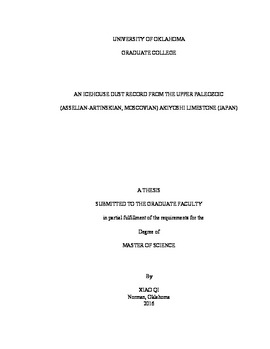| dc.description.abstract | The Akiyoshi terrane in southwest Japan consists of a subduction-generated accretionary complex of shallow-marine limestone and deep-water spicular chert, underlain by ocean island-type basalt, all of which was obducted in late Permian (Capitanian-Wuchiapingian) time. The limestone and chert formed as atoll carbonates and slope deposits on and around a basaltic seamount during Viséan to Guadalupian time of the Late Paleozoic Ice Age (LPIA) in the open ocean realm of the Panthalassic ocean. This unusual paleogeography indicates that the Akiyoshi atoll formed isolated from continental terrigenous input excepting that related to eolian delivery. Thus, the detrital fraction preserved in the limestone archives a record of atmospheric dust.
Two stratigraphic sections recording the upper Asselian disconformably overlain by the upper Artinskian and the middle-upper Moscovian of the Akiyoshi Limestone exhibit facies ranging across wackestone, packstone, grainstone and boundstone fabrics, recording shallow marine deposition. Lithofacies variations in all three intervals commonly record repeated upwardly shallowing successions. The Moscovian and Asselian intervals preserve subaerial exposure surfaces interpreted to reflect glacioeustatic lowstands formed during more intense glaciations of the LPIA, whereas the Artinskian interval lacks evidence for subaerial exposure surfaces, consistent with formation at a time when the LPIA was waning.
The dust fraction extracted from the study sections comprises both clay and subrounded to subangular, very fine silt- to fine sand-sized quartz, indicating a long-transport, continentally sourced eolian dust. Selected horizons contain relatively coarse-grained angular volcanic fragments recording discrete explosive volcanism from differentiated arc sources. The dust content (weight percentage) varies over two orders of magnitude, reflecting greater dust input during the Moscovian and Asselian in general, and during glacials relative to interglacials. Thus, atmospheric dust loading covaries positively with ice volume of the LPIA in general, and at the Milankovitch glacial-interglacial time scale. The most proximal source for the andesitic volcanic input is arc magmatism of the North China block. Furthermore, the grain size mode of the Moscovian dust is much finer (34 µm) than that of the Artinskian (139 µm), This shift is interpreted to reflect a provenance shift, form arid regions of western equatorial Pangaea to those of eastern equatorial Pangaea. | en_US |
